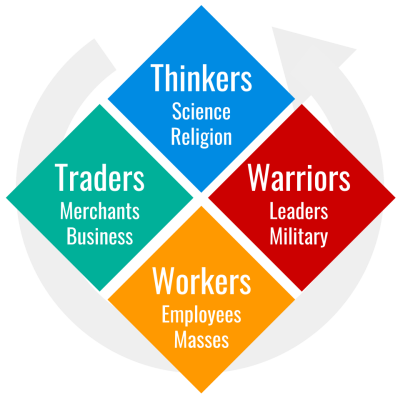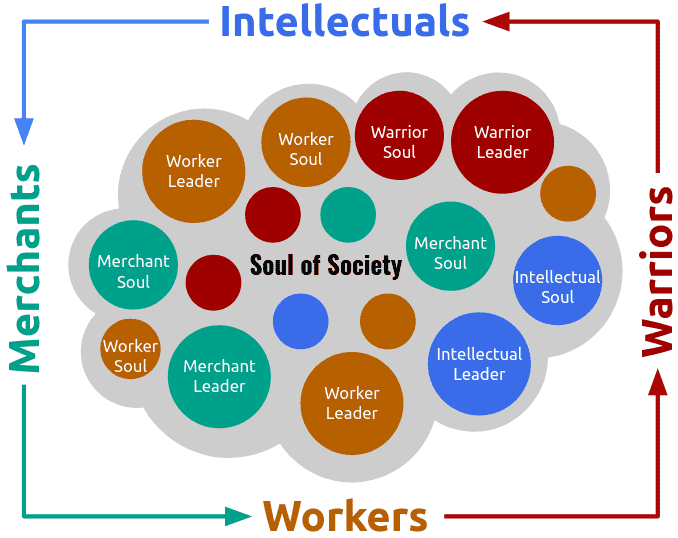The Law of Social Cycles by Socrates
Table of Contents
According to Socrates, all societies have alternating cycles that begin with democracy that switches to tyranny, then aristocracy, then oligarchy, and finally back to democracy.
| Time | Cycle | Dominant People | Positive Aspect | Negative Aspect | Description |
|---|---|---|---|---|---|
| 1 | Democracy | Working-class | Social justice | Chaos and mob rule | The democratic chaos leads people to want order, paving the way for tyranny |
| 2 | Tyranny | Warriors, leaders, and generals | Peace and order | Abuse and corruption | The tyrannical abuse leads people to want wisdom, paving the way for aristocrats |
| 3 | Aristocracy | Intellectuals and thinkers | Wisdom, scientific, and cultural advancement | Dogma and stagnation | The stagnation leads people to want material wealth, paving the way for oligarchs |
| 4 | Oligarchy | Traders, speculators, and businessmen | Material progress | Inequality and environmental destruction | The injustice leads people to want justice, paving the way for democracy |
How does oligarchy change into democracy? Is it wise or not?.. Democracy grandly tramples on the fine principles which we laid down at the foundation of the city, through her forgiving spirit, and the ‘don’t care’ about trifles. She never makes the pursuits which make a statesman.
Socrates
The Republic by Plato, Book 8
The four classes and cycles mirror the four varnas of Hinduism:
- Shudras as the workers
- Ksattriyas as warriors
- Brahmins as the thinkers, philosophers, and priests
- Vaesyas as the traders and businessmen
We then match them roughly to the modern classification:
| Class Name | Political Class | Hindu | Socrates |
|---|---|---|---|
| Workers | Socratic* Liberals | Shudras | Democrats |
| Warriors | Socratic Neoconservatives | Ksattriyas | Tyrants |
| Thinkers | Socratic Conservatives | Brahmins | Aristocrat-Philosophers |
| Traders | Socratic Neoliberals | Vaesyas | Oligarchs |
*We add ‘Socratic’ to separate them a bit from the modern classification, while having some resemblance
w-W-t-T
An easy mnemomic is “w-W-t-T” which stands for Worker-Warrior-Thinker-Trader. In this way:
- Socialists, Liberals, and American libertarians fall under Workers or Socratic Liberals
- Dictators, Generals, Communists (deployed Marxism), and Fascists fall under Warriors or Socratic NeoCons
- Priests, Technocrats, Researchers, Marxists, and Nazis fall under Thinkers or Socratic Conservatives
- Big Businesses, Free marketeers, Bankers fall under Traders or Socratic NeoLiberals
The ‘w’ of the worker is small to represent the natural dominance of the warriors and leaders over them, just as the ’t’ of thinkers is small just as researchers always ask for grant money and priests ask for donations.

This makes:
- Workers and Traders as the Socratic Left Wing
- Warriors and Thinkers as Socratic Right Wing.
Here, Left Wing represents matter (such as money), while Right Wing represents the immaterial (such as the soul or ideas).
We use this model to expose the current cycle of any society, based on the outcome of events. For example:
- a successful popular protest that topples a government indicates that the country is in a worker phase
- a successful military crackdown of that protest, on the contrary, will indicate that the society is in a warrior phase
We use outcomes of changing events* to reveal the soul of the society, just as dust reveals an invisible object by establishing that object’s outline.
*This is what Hegel had in mind when he mentioned dialectics.

These cycles then reveal the soul of the society, the most important aspects of which are its age and phases.
- Is a society metaphysically young and rising or old and stagnating?
- Has a country’s soul been recently replaced by a new one?
Society must therefore have its infancy, youth, manhood, and old age, similar to that each individual form which it contains. Man has these variations equally with every animal and plant.
David Hume
Essays by David Hume Simplified, The Populousness Of Ancient Nations
Theory of Universal Relationality
We plug in this model into our equation-for-everything * to come up with something for machine learning to work on:

Our equation for everything is based on Descartes’ Relationality (Relativty) which is used a lot in Material Superphysics which discards Einstein’s Relativity as a scam.
Social Cycles explain why and how history repeats itself. This is because reality is a wave, and waves are always related to previous and future waves. We give a short story below as an example.
Story (click to expand)
The Story of Survivor Island
One afternoon, a small airplane crashed on a deserted island leaving four people stranded – Mei a female construction worker, Sergeant Arthur an army officer, Albert a scientist, and Meg an ex-CEO.
“We must first make a safe shelter because I heard there’s a big tiger on this island,” says Arthur. “I’ll go out to gather food. The rest should follow Mei in building a shelter.”
The group agrees. After a month, the shelter is finished.
“Good, now we must hunt the tiger to ensure our safety,” says Arthur. He takes the lead in hunting and killing the tiger, which takes a whole month.
“Now that we’re safe, we can think of ways to get out of this island. Any suggestions?” asks Mei.
“It’s been two months since we crashed,” replies Albert. “The search has surely been called off. We must find ways to settle here permanently. I can share my ideas if you let me take the lead.
”The group agrees and soon they change from Arthur’s tactic of hunting animals for food into a longer term strategy of domesticating them and establishing small fish pens.
Without threats and with fewer burdens, the group starts to feel closer to each other and be more relaxed. By the next month, Mei has fallen for Arthur’s bravery, while Meg, for Albert’s intellect.
“I’m pregnant!” Mei shouts. “I’m happy, but our supplies are just enough for the four of us.”
“I’m pregnant too!” Meg responds. “We have to find ways to get more supplies. Since the island is limited, we have to maximize the little resources we have. You should let me take the lead. I want Arthur to chop more wood, Mei to build bigger animal cages and fish pens, and Albert to get the animals to make more milk, eggs, and reproduce faster.”
Within a month, food production is increased dramatically and everyone notices Meg getting fatter.
“You’ve been ordering us around while doing the least work,” exclaims Mei.
“Even if you’re smart, you should work like the rest of us!” The group agrees to put Meg to work like the rest, with Mei taking the lead.
In the past five months, the group’s territory has expanded from the first shelter into deeper areas of the water where a big shark lives.
“We must kill the shark for our own safety! You must let me lead again,” Arthur exclaims.
And so, the group embarks on the new endeavor as they struggle to fully establish themselves on the island.
Why are there four cycles?
Economic Superphysics, the subset of Social Superphysics, explains that the cycles are based on the 4 laws of value which mirror the 4 laws of thermodynamics:
- The Working or Shudra class comes from the First law of Value
- The Warrior or Ksattriya class comes from the Second law of Value
- The Thinking or Brahmin class comes from the Third law of Value
- The Trading or Vaeshya class comes from the the Fourth law of Value
So there are 4 cycles or classes because these represent the desire-energy.
Energy in this universe obeys 4 laws of thermodynamics.
Why does thermodynamics have 4 laws?
This is because there are 2 forces:
- Positive Yang/Shiva (aethereal)
- Negative Yin/Shakti (material).
The thinking class is the closest to the aethereal while the worker class is the closest to material.
So what’s the purpose of Social Cycles?
Prediction!
If you know things happen in a regular cycle, then you can predict what will happen. In fact, this is how we predicted the crisis years starting in 2019 .
Update Jan 20, 2025
We also have a running list of predictions to prove that cycles work and that we exist inside a Matrix.
We use these correct predictions to prove the solidity of the principles discovered by Socrates, David Hume, Hinduism, Buddhism, and Taoism. This is similar to how the solidity of Newtonian Physics was proven by the correct prediction of the arrival of Haley’s comet.
These cycles are based on waves that also apply in all sciences whether as quantum field theory, price theory. waves of epidemics, etc.